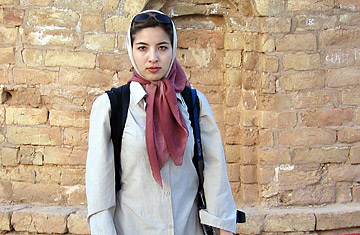
Iranian-American journalist Roxana Saberi
For nearly two weeks, Roxana Saberi has been refusing food. The jailed Iranian-American journalist, who was sentenced by Iran's Revolutionary Court to 8 years in Tehran's Evin prison on charges of spying for the U.S., continues to proclaim her innocence while both President Barack Obama and Secretary of State Hillary Clinton continue to call for her release. So far, the case's presiding judge has not been moved, calling the fast a ploy for propaganda purposes. One judiciary spokesman denied the news altogether: "She is in good physical condition and not on a hunger strike," Ali Reza Jamshidi told the country's official news agency on April 28, two days after Saberi's 32nd birthday and a week after she told her parents she had stopped eating. (The Paris-based group Reporters Without Borders said Saberi was briefly hospitalized after she began refusing water too).
When it comes to publicity stunts, it doesn't get much more desperate — or dangerous — than a hunger strike. From college campuses in the Midwest to the oil fields of Kazahstan, the practice has become a daily, global phenomenon that has been by turns successful, gruesome, tragic and sometimes all of the above. In 1981, a 27-year-old member of the Irish Republican Army named Bobby Sands led a hunger strike at Her Majesty's Prison Maze in Belfast, where he was serving time for gun possession, and used the attention to win a seat in the British parliament. He never served his term, though; he starved to death after 66 days without food. (See pictures of how Northern Ireland has transformed itself.)
The self-destructive act, oddly enough, is a sort of legal tradition in Ireland. As early as the 8th century, villagers aired their grievances and settled disputes by fasting on the doorsteps of their wrongdoers until they were publicly shamed into doing the right thing. The IRA resurrected the practice in 1917, with Thomas Ashe, leader of the 1916 Easter Rising in Dublin, who died in the city's cruelly named Mountjoy Prison during a botched force-feeding. "It is not those who can inflict the most, but those who can suffer the most who will conquer," he declared shortly before his death. Three years later, 89 strikers were released from Mountjoy after less than three weeks without food; their British captors wanted to avoid creating more political martyrs if they could help it. (Read: Site of IRA Hunger Strike Haunts Northern Ireland.") "
India's Mohandas Gandhi staged highly publicized fasts throughout his life, first to protest colonial rule and later to protest Hindu-Muslim violence. He once broke a fast when a group of tearful rioters laid their machetes at his feet. In 2006, newly declassified government records show that Winston Churchill would have preferred to let Gandhi die in prison during his 1942 hunger strike; his war cabinet managed to convince him that this would have been disastrous p.r.
Jailed suffragists like Alice Paul used hunger strikes in the early 20th century to rattle President Woodrow Wilson, who denounced such tactics as appalling and "unladylike," though he later buckled amid a public outcry over the forced feeding of the protesters and agreed to support the 19th Amendment granting women the vote. During World War II, a group of conscientious objectors at Connecticut's Danbury prison staged a 135-day strike against segregated dining. As a result, Danbury became the first federal facility with integrated meals.
Of course, sometimes the sympathy — and the concessions — never come. From 2004 to 2006, Iraqi dictator Saddam Hussein launched three separate hunger strikes during his war-crimes tribunal, protesting that the court lacked legitimacy and had failed to provide adequate security for his defense lawyers (three of his attorneys were killed during the proceedings). But the strikes only resulted in feeding tubes and occasional mockery; one Fox News headline proclaimed: "Saddam Ends Hunger Strike After Skipping One Meal."
In 2006, the United Nations publicly condemned the U.S. military's practice of force-feeding detainees at Guantanamo Bay, likening the act of strapping a person down and forcing tubes up their noses and into their stomachs to torture. Earlier this year, military officials told the New York Times that nearly one-fifth of all Gitmo prisoners were being force-fed at any given time.
Outside prison walls, though, most hunger strikes are carefully planned with an end date in mind. Two weeks ago, Bolivian President Evo Morales ended a 5-day hunger strike to agitate for new election legislation (it worked), while actress Mia Farrow announced that she had gained nine pounds in preparation for a 3-week fast to draw awareness to starvation in Darfur, telling People magazine that magician and publicity generator David Blaine had called to offer some tips from the 44 days he spent suspended in a glass box above London's River Thames without food. On May 3, more than 160 journalists and fellow Northwestern alumni launched a "relay" hunger strike in solidarity with Saberi; volunteers each take a 24-hour shift.
"It's political performance art," one California psychologist said of the nearly 300 fasts he's staged. But for desperate people like Saberi, it's much more than that. As Sharman Apt Russell, author of Hunger: An Unnatural History, wrote, "What else can the powerless, the weak and disenfranchised offer up to the world but their own soft bodies?"
Read: "Why Is Ahmadinejad Helping Journalist Roxana Saberi?"
